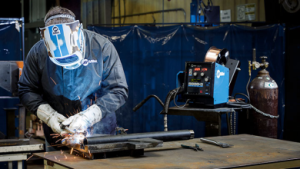
With repairing being such a key feature of the many impressive crafts out there… from huge cruise liners gliding done the seas in luxury, to solid metal cargo boats moving essential goods everywhere our world… it is literally ‘the unseen welder’ behind all these maritime miracles.
Explore the finest silver fusing wire with us! As an authorized dealer for leading expert brands, we offer the most general stock of welding supplies. Visit our website at to browse our products or get expert joining advice from our experts. Don’t miss out on top-tier quality and unmatched handiness in the market!
Welding is the invisible essence of marine applications, providing them with waterproof and strong connections that keep these bowls navigating safely across masses. In this blog post we dip into the stimulating world of welding in marine claims, looking at what it takes to make sure these massive nautical giants are kept seaworthy for maximum safe occupied life and get people on their mode.
Preparing for the Storms of Welding: Basics Techniques
Being exposed to a harsh marine situation with salt water and temperature alterations, requirements for the joining technique used are sturdy, as well as weathering resistant. Some of the boatyards and bowls come across the subsequent categories of welding generally,
Safeguarded Metal Arc Welding (SMAW) It is also known as stick joining Stick electrodes are consumable anodes coated with flux. It has a high penetration rate and it can be castoff on many metals and numerous breadths, thus making this a staple method in any request related to the maritime sector. Shielded metal arc welding is brilliant for on-board repair and upkeep work because it can be used out of doors, or in adverse weather settings.
Flux-Cored Arc Welding (FCAW): Familiarized as a faster replacement for stick fusing, which can be used with thicker steel units like those found in shipbuilding – FCAW involves the custom of self-shielding flux and unceasingly fed consumable wire conductors. Well-suited for on-site joining in shipyards, FCAW can use the host metal as a ground and thus wants no separate gas supply. Its faster fusing speeds and higher infiltration depths over MIG make it the favored method for joining hull sections, beams and other structural machineries.
Flooded Arc Welding (SAW): SAW steals the limelight, but only in high-bulk manufacturing of heavy steel plates/sections and for constructions not subject to impact loading deprived of coatings. It is an automated welding course that uses a continuously fed expendable electrode and a blanket of gritty fusible flux. This flux prevents the weld pond from contaminating and crops a stable arc which allows high welding hurries, penetration. SAW is normally used in the fabrication of large size structural workings such as ship hulls, bulkheads and floors.
Gas Metal Arc Welding (GMAW) or MIG Fusing – providing an easy-to-use course and a clean-looking weld, GSW can be used to pledge thin- to medium-gauge page metal parts in marine applications. A clean weld is shaped by a replaceable wire electrode (approximately 0.05 inch to 1/8 of an-inch thick) that produces the bond using a contact tip and sluggish gas (typically argon or helium). MIG joining can also be used for fabricating non-structural components, such as external railings and air aeration ducts.
Wet or Dry Hyperbaric Joining: Underwater repair exertion or construction require the use of unique hyperbaric fusing strategies. Wet welding : The welder is in the aquatic, separated from 12 work by a aquatic jacket that makes special equipment and process necessary. Dry welding works done placing a pressurized, welded-in), inert gas filled hollow where the welder can perform outdated-type welding techniques. Those operations are underwater, so they require expert welders who know how to run the occupation.
Material Matters: The Right Stainless Alloys for the Sea
Marine applicationsFaces & experimentations 11 Although a Weld in-marine facility may be successful, it is entirely reliant on upon the particular properties of the supplies joined. The following is a rapid of some of the popular shipbuilding steel and welding considerations for each:
Carbon Steel : Increasingly more characteristic in vessel building, Container development requires implausible weld capacity with all the welding outline might be stick MIG or SAW. Mild steel though, has a tendency to corrode in saltwater and so will often obtain coatings or require the use of corrosion resilient steels.
High-Strength Low-Alloy (HSLA): HSLA braces are a kind of MS that accommoda popular in this nautical nsity, MPIIfc-strength ratio position high. HSLA steels are easily weldable by most events while high strength duplex grades need pre-heat treatment to perform well, such is the sensitive countryside of welding and losing or transforming material actions during heat.
Stainless Steels: Stainless steel is used for serious components like pipes, tanks and surface hardware that stay bare to saltwater. When joining stainless steels, unusual welding systems and filler metals are compulsory to preserve the corrosion resistance properties of these amalgams.
Safety – how to guarantee quality, proper edition and all these issues
There are many vital supplies for safe and high-quality filling welding as well, separately from the right choice of welding techniques and resources.
Welding Way Development ( WPS): Welding procedure riders having been documented for all critical shipbuilding machineries and repairs. The WPS provides the welding strictures, filler metal collection and testing procedures necessary to generate high class welds that meet exacting maritime organization society standards consistently and frequently.
Shipyard welder prerequisite: Shipyards put their welders through a combination of drill and physical testing to succeed those who are proficient in welding morals.



